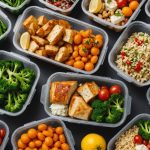Transforming Culinary Packaging: Cutting-Edge Strategies to Reduce Plastic Waste in the UK
The UK food industry is at a critical juncture, faced with the daunting task of reducing plastic waste while maintaining the quality and freshness of food products. In recent years, there has been a significant shift towards sustainable packaging solutions, driven by consumer demand, regulatory pressures, and the industry’s own commitment to sustainability. Here, we delve into the cutting-edge strategies being implemented to transform culinary packaging and reduce plastic waste.
The Problem of Plastic Waste in Food Packaging
Plastic waste has become a major environmental concern globally, and the food industry is one of the largest contributors to this issue. Single-use plastic packaging, in particular, has been under scrutiny due to its limited recyclability and high disposal rates. In the UK, the problem is exacerbated by the sheer volume of plastic packaging used in the food sector.
Also read : Embrace tomorrow: explore cutting-edge innovations in home renewable energy solutions
| Category | Amount of Plastic Waste (approx.) |
|---|---|
| Food Packaging | 40% of total plastic waste |
| Single-Use Plastics | 20% of total plastic waste |
| Other Packaging | 30% of total plastic waste |
| Other Uses | 10% of total plastic waste |
Table: Breakdown of Plastic Waste in the UK
Innovative Packaging Solutions
Several companies in the UK are pioneering innovative packaging solutions to address the plastic waste issue.
This might interest you : Explore the benefits of intelligent lighting solutions for uk urban environments
Tesco and Zespri’s Recyclable Kiwi Packaging
Tesco and Zespri have recently launched a new recyclable packaging for kiwis in the UK. This packaging, known as “ProProduce,” consists of a cardboard tray from Smurfit Westrock and a fruit lid without a backing, significantly reducing CO2 emissions and plastic use. The design includes vibrant graphics and cut-out sections on the lid to reflect the Zespri logo, enhancing the visual appeal while supporting the circular economy[1].
Mondelēz International’s Mono-Paper Packaging
Mondelēz International, in collaboration with Saica Group, has introduced a mono-paper packaging for its LU biscuits. This new packaging reduces the use of virgin plastic by approximately 63% per pack, saving around 177 tonnes of plastic in France, Belgium, and the UK. The paper, certified by the Forest Stewardship Council (FSC), is fully recyclable and ensures the freshness and quality of the products[2].
Key Strategies for Sustainable Packaging
Several key strategies are being adopted across the industry to achieve sustainable packaging:
Use of Recyclable Materials
- Recycled Paper: Companies like Mondelēz International are using FSC-certified paper for packaging, which is fully recyclable and reduces the need for virgin plastic.
- Recycled Plastic: Some businesses are incorporating recycled plastic into their packaging, reducing the demand for new plastic materials.
Reduction in Single-Use Plastics
- Aldi’s Paper Bands for Bananas: Aldi is testing paper bands for bananas, eliminating the need for plastic trays and reducing plastic use significantly[1].
- Reusable Containers: Initiatives like the Dropack project are developing reusable containers to replace single-use plastic packaging[3].
Technological Innovations
- Advanced Biopolymers: Research is focused on creating advanced biopolymers from renewable sources such as starch, cellulose, and sugarcane. These biopolymers, like PLA, PHA, and PBAT, are being modified to improve their mechanical and barrier properties[5].
- Laser Engraving: Tesco is exploring the use of laser engraving for product information, reducing the need for additional packaging materials[1].
Industry Commitments and Regulations
The food industry is not acting alone in this transformation; there are significant commitments and regulations driving these changes.
Plastics Pact and Regulatory Frameworks
- UK Plastics Pact: Many UK businesses have signed the Plastics Pact, committing to make 100% of their packaging reusable, recyclable, or compostable by 2025. This pact also aims to reduce plastic packaging by 40% and ensure that 70% of packaging is effectively recycled or composted[4].
- EU and UK Regulations: Directives and regulations, such as the EU’s Single-Use Plastics Directive, are setting ambitious targets for the reduction and recycling of plastic packaging. These regulations mandate that collectivities and producers take responsibility for the end-of-life management of their products[4].
Practical Insights and Actionable Advice
For businesses and consumers looking to contribute to this sustainable shift, here are some practical insights and actionable advice:
For Businesses:
- Collaborate with Suppliers: Partner with suppliers who offer sustainable packaging solutions, such as Saica Group and Smurfit Westrock.
- Invest in R&D: Allocate resources to research and development to create innovative, sustainable packaging materials.
- Adopt Circular Economy Practices: Implement recycling programs and use recycled materials in packaging to reduce waste.
For Consumers:
- Choose Sustainable Products: Opt for products with recyclable or biodegradable packaging.
- Participate in Recycling Programs: Ensure that you recycle packaging materials correctly to support the circular economy.
- Support Policy Changes: Advocate for stricter regulations on single-use plastics and support businesses that commit to sustainable packaging practices.
Quotes from Industry Experts
- Olivier Kintzig, Director of R&D Packaging Biscuit Europe at Mondelēz International:
“This technical advancement ensures recycling while preserving the quality of the products.” - Marine Stochmil, Engineer at Saica Group:
“Our goal is to improve the sustainability and recyclability of each product.” - Kateline Esperse, Supply Chain Project Manager at Suntory Beverage & Food:
“The construction of a high-storage warehouse adjacent to the production facility is a step towards more efficient and sustainable logistics.”
The Future of Sustainable Packaging
As the industry continues to evolve, several trends and initiatives are shaping the future of sustainable packaging:
Reusable Packaging
- Dropack Project: This project aims to develop reusable containers for fruits and vegetables, significantly reducing single-use plastic packaging[3].
- Citeo’s ReUse Initiative: Citeo is working towards generalizing the use of reusable packaging at a national level in France[3].
Global Cooperation
- International Treaties: The global community is moving towards a unified approach to tackle plastic pollution, with the UN Environment Assembly adopting a resolution to negotiate a global treaty against plastic pollution by the end of 2024[4].
The transformation of culinary packaging in the UK is a multifaceted effort involving innovative solutions, industry commitments, and regulatory support. As consumers become more environmentally conscious and regulations tighten, businesses are compelled to adopt sustainable packaging practices. By leveraging cutting-edge technologies, collaborating with suppliers, and adhering to circular economy principles, the food industry can significantly reduce plastic waste and contribute to a more sustainable future.
In conclusion, the journey towards sustainable packaging is not just a necessity but an opportunity for innovation and growth. As we move forward, it is crucial for all stakeholders—businesses, consumers, and policymakers—to work together to create a packaging industry that is not only sustainable but also circular and environmentally friendly. The future of food packaging is bright, and with the right strategies and commitments, we can ensure that it is also green.











